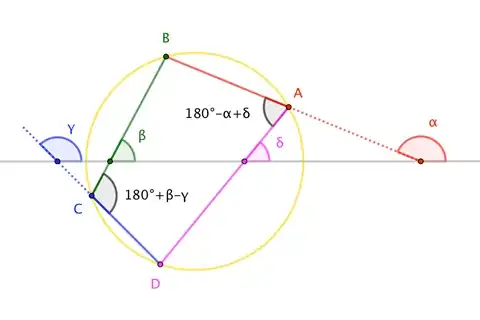Suppose a plane quadrilateral ABCD (convex, concave or crossed) no side of which is parallel to y-axis, and let $m_1, m_2, m_3, m_4$ be the slopes of the equations of sides AB, BC, CD, DA. Having made these definitions, now we may state the following theorem:
ABCD is a cyclic quadrilateral iff $$(m_1m_3-1)(m_2+m_4)=(m_2m_4-1)(m_1+m_3)$$
I can prove this theorem using the theory of circumscribing conics, but I would appreciate if someone could show me a different proof.
Proof based on the theory of conics:
Let $L_1\equiv m_1x -y +r_1=0$, $L_2\equiv m_2x -y +r_2=0$, $L_3\equiv m_3x -y +r_3=0$, $L_4\equiv m_4x -y +r_4=0$ be the equations of lines $AB$, $BC$, $CD$, $DA$.
Then all the conics which circumscribe the quadrilateral ABCD can be given by the equation $\lambda L_1L_3+\mu L_2L_4=0$.
Therefore all the conics circumscribing the quadrilateral are given by the equation $$\lambda(m_1x -y +r_1)(m_3x -y +r_3)+\mu(m_2x -y +r_2)(m_4x -y +r_4)=0,$$ $$(m_1m_3\lambda +m_2m_4\mu)x^2-((m_1+m_3)\lambda+(m_2+m_4)\mu)xy+(\lambda+\mu)y^2+...=0$$
If ABCD is a cyclic quadrilateral, then there is a circle circumscribing it, represented by an equation whose coefficients of $x^2$ and $y^2$ are equal and whose coefficient of $xy$ vanishes. Therefore
$$\begin {cases} (m_1m_3-1)\lambda +(m_2m_4-1)\mu=0\\ (m_1+m_3)\lambda +(m_2+m_4)\mu=0 \\ \end {cases} $$
As this system has to have a solution distinct from the trivial one $(0,0)$,
$$\begin{vmatrix} (m_1m_3-1) & (m_2m_4-1)\\ (m_1+m_3) & (m_2+m_4))\\\end{vmatrix}=0, $$ $$(m_1m_3-1)(m_2+m_4)=(m_2m_4-1)(m_1+m_3),$$
QED.
Conversely, if $$(m_1m_3-1)(m_2+m_4)=(m_2m_4-1)(m_1+m_3),$$ then the system above has a solution $(\lambda,\mu)$ distinct from the trivial one $(0,0)$. Therefore there is an ordered pair $(\lambda,\mu)\neq (0,0)$ which renders the following equation of a conic circumscribing the quadrilateral ABCD:
$$(\lambda +\mu)x^2 +0.xy+(\lambda +\mu)y^2+...=0$$
As $(\lambda +\mu)^2>0$, the conic given by this equation must be an ellipse (and a real one and non degenerate, because this conic passes through four real points), and, more precisely, a circle, because of the equal coefficients of $x^2$ and $y^2$, hence ABCD is a cyclic quadrilateral,
QED.
Note: $(\lambda +\mu)^2\neq0$ for two reasons (one algebric, the other geometric). First, because if $(\lambda +\mu)^2=0$, then $(\lambda +\mu)=0$, then $\lambda=-\mu$, then $m_1m_3=m_2m_4$ and $m_1+m_3=m_2+m_4$, then $m_1=m_2$ and $m_3=m_4$ (absurd!), or $m_1=m_4$ and $m_3=m_2$ (absurd!). Second, because if $(\lambda +\mu)^2=0$, then $(\lambda +\mu)=0$, then the equation wouldn´t have second degree terms, degrading to an equation of a straight line passing through four non collinear points (absurd!)
Is anyone acquainted with another proof?
